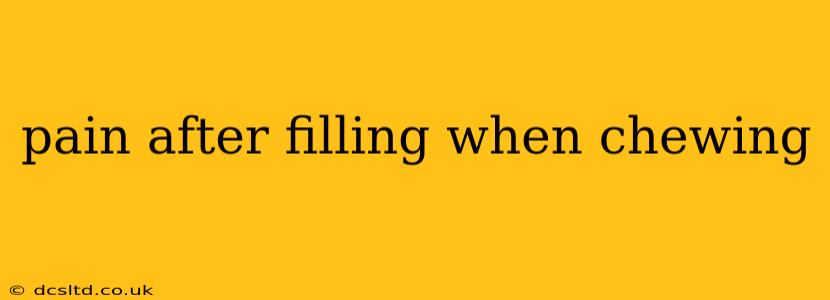Experiencing pain after a dental filling when chewing is a common concern, and it's crucial to understand the potential causes and how to address this discomfort. This comprehensive guide explores various reasons behind post-filling pain, explains when to seek professional help, and offers tips to prevent future occurrences.
What Causes Pain After a Filling When Chewing?
Several factors can contribute to pain after a filling, particularly when chewing. Understanding these causes is the first step towards finding effective relief.
- Irritation of the tooth: The filling procedure itself can sometimes irritate the tooth's nerve, leading to temporary sensitivity. This is often more pronounced when pressure is applied during chewing.
- High filling: If the filling is placed too high, it can interfere with your bite, causing pain and discomfort when chewing. This uneven bite puts extra pressure on the tooth.
- Infection: In some cases, an infection can develop beneath the filling, causing persistent pain and potentially leading to more serious complications. This is less common but requires immediate attention.
- Fractured tooth: A pre-existing crack or fracture in the tooth may have been exacerbated during the filling process, resulting in pain when chewing. This pain may be sharper and more localized than simple irritation.
- Gum irritation: The filling process may have caused minor irritation to the gums surrounding the tooth. This can manifest as tenderness and pain when chewing.
- Sinus infection: In the case of upper molars, pain might be referred from a sinus infection. This is not directly related to the filling itself.
- Incomplete removal of decay: If the dentist didn't completely remove all decayed portions of the tooth before placing the filling, residual decay can cause ongoing pain and infection.
How Long Should Pain After a Filling Last?
The duration of post-filling pain varies. Mild sensitivity is often temporary, resolving within a few days to a couple of weeks. However, persistent or worsening pain necessitates a visit to your dentist. This distinction is crucial; transient discomfort is normal, but prolonged or intense pain suggests an underlying issue.
When Should I See a Dentist About Post-Filling Pain?
Don't hesitate to contact your dentist if you experience:
- Severe or persistent pain: Pain that doesn't subside after a week or two warrants professional evaluation.
- Increased sensitivity to hot or cold: While some sensitivity is expected, significant or prolonged sensitivity indicates a potential problem.
- Swelling or inflammation: Swelling around the filled tooth is a sign of potential infection and requires immediate attention.
- Pain that radiates: Pain that spreads beyond the filled tooth could suggest a more complex issue.
- Pain accompanied by fever or other systemic symptoms: This indicates a more serious infection requiring medical attention.
Can Post-Filling Pain Be Prevented?
While not always preventable, you can take steps to minimize the risk:
- Choose a reputable dentist: Selecting a skilled and experienced dentist is crucial for minimizing the risk of complications.
- Maintain good oral hygiene: Brushing and flossing regularly helps prevent infections and keeps your mouth healthy.
- Follow post-operative instructions: Adhering to your dentist's instructions carefully after the procedure is essential for optimal healing.
- Avoid chewing on hard foods: Give your tooth time to settle by avoiding excessively hard or chewy foods for a few days after the filling.
What Treatments Are Available for Post-Filling Pain?
Treatment options depend on the underlying cause:
- Adjustment of the filling: If the filling is too high, your dentist can easily adjust it to relieve pressure.
- Medication: Over-the-counter pain relievers like ibuprofen can provide temporary relief. Your dentist might prescribe stronger medication if necessary.
- Root canal: In cases of severe infection or nerve damage, a root canal might be required to save the tooth.
- Extraction: In rare cases, if the tooth is severely damaged or unsalvageable, extraction may be necessary.
This information is for general knowledge and does not constitute medical advice. Always consult your dentist for diagnosis and treatment of any dental pain. Regular dental checkups and good oral hygiene practices are crucial for maintaining good oral health and preventing dental problems.
